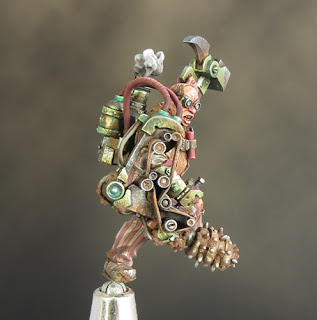When Squarg came away from Euro Millitaire without even a ‘commended’ to his name I was deeply disappointed. To be honest, I felt that that was in no way a fair assessment of the mini but, as I said at the time, ‘that’s the way the cookie crumbles’ and the best thing to do was move on and get painting.
I’m normally extremely reluctant to go back and make changes to a ‘finished’ mini. That’s not to say that I consider my work to be perfect! But I think it’s far more positive and productive to take the lessons learned and apply them to future projects. However, I decided that Squarg was a special case.
Although I didn’t seek any feedback I heard from several friends that there had been some comments about Squarg from the judges at Euro. Feedback is only ever going to be of use if you take it with an open mind and I was in no fit state at the time.
The first thing that reached my ears from several sources was that the frog should have looked wet. The second was that Squarg’s back feet were not properly fixed to the base.
With the passing of time I was able to get Squarg out of the cabinet and reconsider him objectively. I still felt that Squarg was one of my best pieces and he deserved a fair crack of the whip. But only a fool refuses to consider feedback.
The issue of how wet the frog should look was something I’d given a lot of thought to when I first painted him. I made tests with different finishes in an effort to achieve a suitably moist appearance but I decided to leave well alone. Shiny finishes looked tacky and unrealistic while satin finishes were not noticeably different from the natural sheen of the paint that I’d used, a mix of Vallejo & GW. The decision I made was right. I’m still perfectly happy with it and I stand by it.
The back feet were a different matter. I knew that Squarg’s feet had been properly fitted to the base. I’d gone to great pains gently heating them so that they could be reshaped to fit the contours of the base. But what I’d missed was that they hadn’t stayed that way for very long! In particular there was a noticeable gap between Squarg’s back left foot and the base!
I think the most likely explanation is that the original (very flat) shape of Squarg’s feet reasserted itself when I used a hairdryer to speed up the drying of some washes I’d applied to the base. And while in hindsight the gap looks obvious, I had totally missed it at the time.
All well and good but what should I do about it? There was no way I would be attempting to reheat and bend the foot again, so I decided to fill the gap with something. After consideration that ‘something’ was more grass and moss.
I had the Friday before Salute free to work on Squarg’s base and it was an extremely nervous day! I proceeded slowly by very carefully testing out several options before I had my solution. The use of a soft material meant that I could safely work it deep into the gap and then tease it back out for a natural effect. In the end I was very pleased with the result. The gap was no longer apparent and the new grass and moss looked like it had always been there.
The extra grass and moss didn’t just fill up the gap in my opinion the base looked better with them. This led me to consider the overall appearance of the base and so I decided to increase the amount of green on the base.
I did this in several ways:
1.
I added a few more strands of tall grass at the back of the base. On reflection the old grass formed two distinct clumps – one in each back corner and I wanted to soften these out
2.
I tinted the leaves on the tall grass at the back with a warmer shade of green that toned in with the frog’s flesh colour. I think that before the leaves were too pale and cool in tone
3.
I went back over much of the ground surface with glazes of green ink
4.
I added a mix of green ink, paint, PVA glue and baking soda to specific areas of the ground. This created areas of a fine, slightly soft, grainy texture that really helped to give the ground a damp marshy look.
The actual change to the appearance of the base is subtle but it has a dramatic effect. With the overall increase of green the individual plant elements are slightly less distinct and now work better together as a whole. The base also now has a damper look to it more appropriate as the environment for a frog.
I was far less nervous at Salute this year than is usual for me. That’s due to the event being more familiar rather than any growth in confidence. In the case of Squarg, I very much wanted him to do well but I really had nothing to lose as he couldn’t do any worse than he had done at Euro.
Winning both First Place in his category and Best in Show is marvellous and I’m very proud of the achievement.
I’ve experienced both the extreme highs and lows of competitive painting with this one mini and it’s a slightly odd experience with each tempering the other.
In the end, I think the lesson Squarg has taught me is try not to be too overwhelmed by either success or failures because positive things can be found in both if you look for them.























